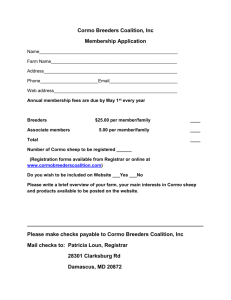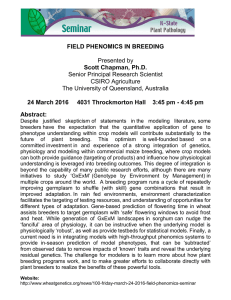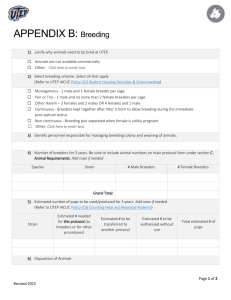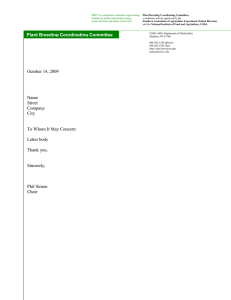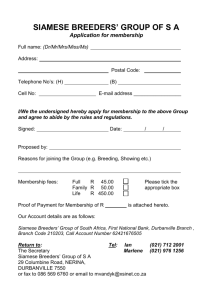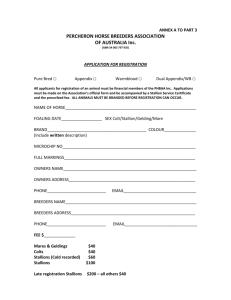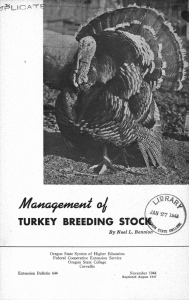TURKEY BREEDING STOCK 1111111f10(11101T Of By Noel L. Bennion
advertisement
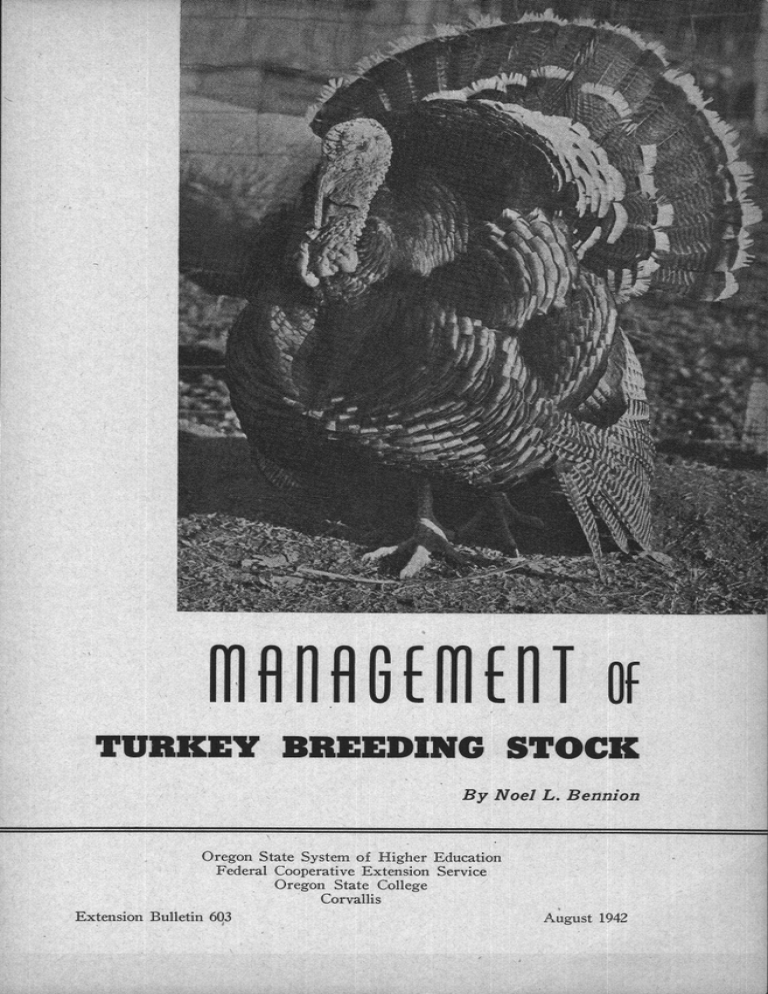
.0* 1111111f10(11101T Of TURKEY BREEDING STOCK By Noel L. Bennion Oregon State System of Higher Education Federal Cooperative Extension Service Oregon State College Corvallis Extension Bulletin 60,3 August 1942 TABLE OF CONTENTS - Page Summary 3 Introduction 5 Equipment for Handling Breeders 5 Catching Equipment 5 Nests 5 Roosts and Feeders 6 Watering Devices 7 Broody Pens 7 Shelter and Lights 7 Tom Pens 8 Selecting Breeders 9 Turkey Varieties 9 Qualifications of Breeders 9 Time to Select Breeders 11 Management of Breeding Flock 12 Feed and Care of Hens 12 Feed and Care of Toms 15 Rations 16 Green Feeds 17 Fertility and Hatchability 18 Broody Hens 19 Early Eggs 21 Care of Hatching Eggs 22 Sanitation and Disease Prevention 23 Cooperative Extension Work in Agriculture and Home Economics Wm. A. Schoenfeld, Director Oregon State College and United States Department of Agriculture, Cooperating Printed and distributed in furtherance of the Acts of Congress of May 8 and June 30, 1914 - SUMMARY 3. The following equipment should be available in handling breeding stock : catching equipment, nests, roosts, feeders, watering devices, broody pens, torn pens and shelter with artificial lights if early eggs are desired. It is desirable to have all equipment portable or constructed so that it can be moved to clean ground in case of a disease outbreak and to avoid soil contamination dangers. Turkey breeders should be birds that are broad-breasted, well-balanced, early-maturing, and well-feathered at an early age. 4. 5. Breeders should be changed from a growing mash to a breeders' mash and adequate green feed 4 to 6 weeks before hatching eggs are desired. At least ten to twelve toms should be selected for each 100 hens. Some system of rotating the toms seems to improve fertility. It is difficult to obtain good fertility with extremely large, awkward, unbalanced male birds. Hatchability is an inherited characteristic but is influenced by many other factors. Fertility may not be inherited directly, but it seems that several inherited factors have a bearing on fertility, such as conformation, symmetry, and action. In selecting breeders, if records are available, individual and family performances of such characteristics as fertility, hatchability, livability, rate of maturity, and egg production should be considered. Early egg production can be stimulated through the use of artificial lights and shelter. If early eggs are desired, the lights should be started on the hens 4 weeks and the toms 8 weeks before eggs are desired. Hatching eggs should be gathered five or six times per day, cleaned if dirty, and kept at a temperature range from 45 to 60 degrees with a relative humidity above 85 per cent. Fertility and hatchability are both influenced by the environment in which eggs are held from the time they are laid until they go into the incubator. Sanitation, coupled with good management, is the main factor in controlling and preventing turkey diseases. If a disease outbreak occurs, the sick birds should be isolated and if possible the flock moved to clean ground. An accurate diagnosis should be obtained as soon as possible. Drugs or medicine in the drinking water or feed will not prevent diseases. Figure 1. A nest house with inside view of nest arrangement. The nests are 2 feet square, 1 foot deep, and 18 inches above the ground. Management of Turkey Breeding Stock By NOEL L. BENNION, Extension Poultryman* INTRODUCTION Oregon turkey growers normally keep from 200,000 to 225,000 turkey breeders, which produce more than 4,000,000 poults. About 50 per cent of these poults are brooded on Oregon farms, while the other half is exported as poults or hatching eggs to various parts of the United States. Oregon has been a leading state in the development and production of Broad-Breasted Bronze turkeys. Many growers specialize in the production of this type of stock to be sold as breeders, hatching eggs, or poults. Some producers are trapnesting, pedigree hatching, and making use of family performances and progeny testing in their program of flock improvement. Commercial operators buy both toms and females from the specialized breeders, as a means of improving their flocks. Oregon also has some outstanding breeders of standard bred White Holland, Narragansett, Bronze, Black, and Bourbon Red turkeys of good market quality. EQUIPMENT FOR HANDLING BREEDERS Catching equipment. Adequate equipment is essential in breeder management so that prospective breeders can be handled individually with a minimum of labor and injury to the birds. A catching chute or a panel corral with a small adjacent pen are two types of equipment most commonly used when handling individual birds. The corral with pen is the most desirable because the birds can be observed on the ground for symmetry and action before being caught for further inspection. With this system 40 to 50 birds at a time may be moved from the corral to the small pen until all birds in the entire flock have been examined. Nests. Many different kinds of nests are used for turkeys, but regardless of the design the hens have a tendency to lay in groups. Several mechanical nests have been designed to prevent the birds from piling or crowding, but none of them has proved practical. The author wishes to express appreciation and thanks to Professor H. E. Cosby, Head of the Poultry Department, for his help and cooperation in preparing this publication. Cover illustration by Alfred A. Monner. - 6 EXTENSION BULLETIN 603 Some growers prefer the central nest houses while others prefer the small A or rectangular shaped nests. A nest 2 feet square and 1 foot deep is frequently used. Some growers use a long continuous nest 2 feet wide, 1 foot deep, without partitions. Nest houses are usually 8 feet wide and 10 to 20 feet long. The nests are built from 1 to 2 feet above the ground on both sides of the houses and sometimes across one end. These houses should be well ventilated and constructed on skids so they can be moved readily. Roosts and feeders. Breeders should be provided with low roosts not more than 2 or 3 feet above the ground. High roosts are a potential source of injury especially to large heavy toms. They I . Figure 2. Three types of nests frequently used. The rectangular shaped nests are both 2 feet wide, 6 feet long, and 2i feet high. The A shaped nest at the base is 4 feet long, 3 feet wide, and 2 feet high. MANAGEMENT OF TURKEY BREEDING STOCK should be made from smooth poles from 24 to 5 inches in diameter or 2 x 3 or 2 x 4 inch material with the broad side up. They should be built on skids so they can be moved enmasse. At least 1 linear foot of roosting space should be provided for each breeder. Feeders should be constructed so they can be moved from contaminated locations. One feeder 10 feet long, 12 inches wide, 18 inches high, with a hinged top, for each 100 birds is satisfactory. The trough part should be 12 inches wide, 10 inches deep, and edged with lath to prevent feed wastage. a This leaves space on each side 8 inches high interspaced with slats through which the birds eat. D, Watering devices. Of the many different kinds of watering devices used, it is essential to have equipment that can be moved, that is easy to clean, and that will contain an adequate supply Figure 3. Feeders should be portable, designed to of water., Natural waterprotect the feed and prevent wastage. One 10-foot hopper with feeding space on both ing places or wet soil areas sides should be provided for each 100 birds. around drinking equipment should be avoided because they provide favorable conditions for the development and spread of diseases and parasites. Broody pens. A system of handling broody hens that works fairly well is to have four adjoining pens, each about 20 feet square. There should be a gate from one pen to another so the hens can be conveniently rotated. Each pen should be equipped with feed and water facilities. The pens should be made from panels or material that can be moved because if left in the same place too long the ground becomes contaminated. Shelter and lights. If early eggs are desired artificial lights and shelter are a worth-while investment. The same shelters used 8 EXTENSION BULLETIN 603 for growing turkeys on range can be used for the breeders during the winter and early spring months. The most common shelter is a shed-roof type with open front and sides, built on 4kids. It is 16 feet long, 10 feet wide, 7 feet high in front, and 4 feet high in the back. Several of these shelters can be placed side by side to make one long continuous shelter for breeders. Roosts can be placed under the shelters or out in front. There are some advantages in having the breeders roost under the shelters ; however, similar results will be obtained if the roosts are in front and situated so that the shelters provide a windbreak. 0 Figure 4. Turkey breeders should have low roosts built on skids. At least 1 linear foot of roosting space should be provided for each breeder. Some growers have built long continuous well-ventilated roost- ing shelters that are closed on all four sides. Others have used regular chicken houses or remodeled barns for roosting quarters. If artificial lights are used, one 50 watt light should be provided for approximately each 100 square feet of roosting space. The lights should be equipped with reflectors and placed 6 to 10 feet above the roosts and so placed that the light shines on the roosts, watering devices, and at least some of the feeders. Tom pen. Provision should be made to care for the extra toms and to hold others during the rest period if a rotation program is followed. The size and arrangement of the pen will depend upon the number and system used in handling the toms. Sufficient space should be provided with adequate feed and water facilities. It is MANAGEMENT OF TURKEY BREEDING STOCK desirable to have the torn pen out of sight from the breeding pens to avoid fighting and fence walking. SELECTING BREEDERS Turkey varieties. The American Standard of Perfection lists the following six varieties of turkeys, commonly called breeds : Bronze, Narragansett, White Holland, Black, Slate, and Bourbon Red. Although the Broad-Breasted Bronze is not listed in the American Standard of Perfection, it is generally considered a separate breed or variety. Producers should bear in mind that there are good and poor individuals in all strains and breeds. The breeding and quality of the stock under consideration are much : more important than the strain or breed. Qualifications of breeders. Breeding stock should be earlymaturing, well-balanced, broad-breasted, and rapid feathering. The symmetry and action of the birds should be given especial consideration in selecting breeding stock. It is difficult to obtain high fertility with extremely large, awkward, unbalanced, inactive birds. They should have free and easy action when walking and any tendency to tip forward should be avoided. The thighs should be large and well fleshed, but clean cut around the hock. The legs should be of medium length, strong, straight, and attached well forward to give the bird proper balance. The breast should be broad, heavily fleshed, and should carry its width well back. The width of the breast at a point 1 inches above the keel should be at least 34. inches for both males and females. This measurement can be taken by placing a piece of lead tape oyer the breast near the front of the keel. After the lead tape has been fit firmly over the breast it should be removed and traced on a piece of paper. The width of the breast is measured from the arch traced 11 inches from the top. The lead tape should be 12 inches long, 1 inch wide, and about of an inch thick so that it will maintain its shape when removed from the breast. (See Figures 5 and 6.) should be 12 inches long, 1 inch wide, and about of an inch thick so that it will maintain its shape when removed from the breast. (See Figures 5 and 6.) The keel bone should be free from a knob, comparatively long, straight, and practically parallel with the back. The back should be wide, flat, and carry its width well toward the rear. Breeding stock should be at least 8 months of age at the beginning of the breeding season. Broad-Breasted Bronze young toms 10 EXTENSION BULLETIN 603 should weigh in the neighborhood of 25 to 30 pounds and the hens 15 to 20 pounds when about 8 months old. Weights for the six standard breeds of turkeys are given in the American Standard of Perfection. Figure 5. (A) Conformation of a well-developed, broad-breasted bird. of a narrow-breasted, slab-sided bird. (Ii) Conformation MANAGEMENT OF TURKEY BREEDING STOCK 11 If pedigreed birds are being selected, family averages and the performance of the ancestors should be taken into consideration on such characteristics as fertility, hatchability, livability, egg production, and rate of maturity. Figure 6. A piece of lead tape 12 inches long, 1 inch wide, and about * of an inch thick, can be firmly fit over the breast to determine the width of breast of prospective breeders. Time to select breeders. To identify the fast-growing, earlymaturing birds, it is desirable to examine the prospective breeders at least once during the growing period from 16 to 18 weeks of age. There will be a wide variation in the size and rate of growth at this age. With this system the birds should first be examined on foot and the most likely looking ones caught and weighed to make sure they are making early growth and gains. They should also be examined for breast development, conformation, rate of feathering, leg and body defects. The birds should be marked with some means of identification or kept separate from the rest of the flock. It is impossible to identify these birds that are making the early gains if the breeders are not selected before the majority of the flock reaches maturity. The final selection should be made from 24 to 26-weeks of age and before any birds are marketed. If the prospective breeders have been examined at an early age, the same birds should be rein- EXTENSION BULLETIN 603 12 spected to determine if they have continued to make rapid growth,' are well-matured, and free from defects. ,i,,. 1,5. ,....,, ,:._ , . .. . Ali -. ,, tit, ' cree. ,. -yr - Nr. , III t iro - . -* 0. --. -- - . t, I' , ,v c "--.--.,14 -ei,,d. r c , 1 -° d '1' ;:, 1 :IA ^-,.. r t` .., ......... , 4i. - 0,11 ' if ...6, ... Li , $ ._,.... _ ...7.0( . - -,..._.,u5--:trc_lip.,,,o%ixts,!::,4..t,,,, -....--y;.., .4),(1...r.!.ev.A.:,.:.,, .. .- ,m,tioi - en tr., --/:.!-1-;0,17 t r ,iiril, s_-.: .. 1 :ii.-_,.. let' I. - te 1. f e'r -4 :0+ Figure 7. __- Turkey breeding stock should be selected before any birds go to market. -selecting breeders at any age they should be weighed and , their weights checked with growth standards. Table 1. GROWTH STANDARDS FOR BRONZE TURKEYS Broad-Breasted Bronze Age Standard Bronze* Males Females Males Females Pounds Pounds Pounds Pounds .75 4 weeks .90 .80 .86 2.68 ' 3.13 3.30 2.75 8 weeks 5.28 7.30 6.00 6.54' 12 weeks 7.67 8.90 10.35 16 weeks. 12.00 14.47 9.67 20 weeks 16.70 11.40 11.15 14.20 18.23 21.40 24 weeks 20.18 12.04 26 weeks 23..50 15.70 12.48 21.35 25.50 16.70 28 weeks 13.28 . 23.35 17.50 30 weeks 27.50 13.37 28.50 18.00 ' 23195 32 weeks * Standard Bronze weights taken from Turkey Management by Marsden and Martin. MANAGEMENT OF BREEDING FLOCK Feed and care of hens. After the breeder hens have been selected they should be put in a group by themselves and given a ration consisting of free choice of growing mash or pellets, a mixture of whole grains, a hard insoluble grit, and oyster shell. If the ration contains an adequate supply of calcium, the oyster shell can . MANAGEMENT OF TURKEY BREEDING STOCK 13 be eliminated. Turkey breeders should have access to a good source of green feed at all times. In order to obtain high fertility and hatchability, the breeding flock must be in good physical condition. If they are thin, run down, or excessively fat, both fertility and hatchability may be reduced. Field observations indicate that more trouble is encountered with breeders being too thin than too fat. Producers should bear in mind that turkey breeders will lose from 15 to 20 per cent in weight Figure 8. At least one trapnest should be provided for every four hens. The dimensions of this nest are as follows: 14 inches wide, 24 inches deep, 19 inches high in front, and 45 inches high in back. during the hatching season. For this reason they should be in good physical condition when the season starts. There seems to be some correlation between this gradual loss in body weight and reduced hatchability as the laying season progresses. It may be that if body weight could be better maintained at least some of the seasonal reduction in fertility and hatchability might be lessened. From 4 to 6 weeks before hatching eggs are desired the breeders should be changed from a growing mash to a turkey breeder mash. They should also continue to have free access to mixed whole grains, grit, oyster shell, and green feed. Breeders should consume approximately 50 per cent of their ration in mash and 50 per cent in grains by weight during the hatching season. 14 EXTENSION BULLETIN 603 Mature breeding hens will consume approximately 31- pounds of mash and grain per week. Supplemental feeds are sometimes used with turkey breeders in an effort to stimulate production and maintain body weight. The most common procedure is to give the birds what mash, moistened Figure 9. A series of three trapnests. Trapnesting and pedigree breeding are essential for application of the progeny test and family performance in a breeding program. with skim milk, or what pellets they will clean up in 30 or 40 minutes fed daily at noon. If skim milk is available on the farm, it can be fed in liquid form by allowing free access to it along with the normal feeding program. Turkeys will balance their own ration if they have a free choice of adequate feeds. Saddles should be placed on the hens before the toms are put in the breeding pens. (See Figures 1, 2, and 4.) Breeders that are housed should be provided with at least 10 square feet of floor space per bird and should have access to an outside yard two or three times as large as the house. Very few producers in Oregon keep their breeders in confinement. MANAGEMENT OF TURKEY BREEDING STOCK 15 Feed and care of toms. The toms should be cared for in a manner similar to that of the hens during the winter months. After they have been selected they should be held in a group by themselves. Toms should have free access to growing mash or pellets, mixed whole grains, a hard insoluble grit, oyster shell, and green Mature toms will consume about 6 pounds of mash and grains feed. forn,"" II . MN. Figure 10. _a A panel corral with a small adjacent pen for examining prospective breeders. per week. They should be in good flesh when the season starts because they lose weight after they are placed in the breeding pens. Some producers make it a practice of exercising the toms daily in an effort to keep them active. There seems to be no one best system for handling toms during the breeding season. It is sound economic protection to have plenty of toms, at least ten or twelve for each 100 hens. Regardless of the system used, the male birds should be placed with the hens at least 30 days before hatching eggs are saved. Rotating the toms in some manner seems to produce somewhat better fertility. Some producers obtain fairly good results, however, by placing the toms with the hens and leaving them there during the entire season. With this procedure extra toms are held in reserve for replacements. Some producers divide the toms into two groups, one set being used during the first half of the season and replaced by the other group for the second half. Others divide the toms into two or three groups and rotate them every other day or every few days. An-' 16 EXTENSION BULLETIN 603 other system used with fairly good success is the use of an individual pen 10 to 15 feet square for each male. The pens should be enclosed on at least two sides to prevent interference with mating, and fighting, and the openings in the fronts arranged so the hens can pass through freely while the toms remain confined. The feeding should all be done in the pens where the toms are located, or else have it arranged so the hens have to pass back and forth through the pens for feed and water. Where the pen system is used it seems desirable to rotate or alternate the toms. Hens mate most frequently prior to the time they start to lay a clutch of eggs. For this reason it is desirable to place one or two toms in each broody pen to increase the number of matings at this time to improve fertility. The toms should have free access to a breeder's mash or pellets, mixed grains, grit, greens, and water while in the rest pen. , 1 .1 rot (1 i! ye, nigToctur. Figure 11. houses. Turkey breeders equipped with low watering devices, feeders and nest This equipment is all built on skidsroosts' so that it can be moved easily', to fresh green .feed and to avoid soil contamination. Rations. The breeder mash is probably the most important of all feeds fed because it contains an additional supply of vitamins A, D, and G (Riboflavin), and other factors essential for high hatchability and livability of the poults. If the ration is deficient in any one of these vitamins, egg production, hatchability, and livability of the poults will be reduced accordingly. There is a high. correlation between the quality of ration the breeders receive and hatchability, and livability of the poults during the early stages of the brooding period. The main sources of vitamin A are green feeds, vitamin-bearing oils, and yellow corn. Vitamin D may be supplied through sunshine, vitamin-bearing oils, artificial ultraviolet rays with certain types of lights, or by irradiated animal sterols. Vitamin G (Riboflavin) is 17 MANAGEMENT OF TURKEY BREEDING STOCK found most abundantly in milk, whey, green feeds, yeast, liver, and dried distillers' solubles. There is very little difference in the feeding value of wheat, corn, and barley, but oats are a little higher in fiber. A combination of three or four grains makes a better feed than any one or two. If any particular grain gets out of line in price, the amount used can be reduced or eliminated and replaced with other grains. Barley is not as palatable as the other grains ; if turkeys learn to eat it at an early age, however, they will readily consume it. There are several reliable prepared breeder mashes on the market. Table 2 contains the turkey rations recommended by Oregon State College. These rations contain an adequate supply of the known nutrients to make up a balanced ration for turkeys of different ages. Table 2. OREGON STATE COLLEGE TURKEY RATIONS Starting Ingredients mash Pounds Bran Ground yellow corn Ground wheat Ground oats Ground barley Meat scraps Fish meal Dry skim milk Dried whey Alfalfa leaf meal Oyster shell flour Steam bone meal Salt Vitamin-bearing oil 400 D-1000 A or its equivalent Manganese sulphate TOTALS Protein Developing mash or concentrate pellets mash Pounds 300 300 330 200 200 100 200 300 300 325 100 100 200 180 100 100 200 20 Pounds 250 100 100 200 mash Pounds 300 300 380 250 100 100 100 100 100 200 20 50 50 200 20 30 20 12 4 4 12 2,007 2,004 1,014 2,012 5 50 50 200 20 30 10 Breeders 10 40 20 These rations, which were developed over a period of years in experimental and field trials, will of necessity have to be modified from time to time in order best to meet the emergencies arising from the changing conditions incident to war. SCRATCH GRAIN MIXTURES Starter 1000 lbs. cracked wheat 1000 lbs. cracked corn Developer or Breeder 1,000 lbs. wheat 400 lbs. corn 300 lbs. barley 300 lbs. oats Green feeds. Young succulent green feed is an especially valuable addition to the breeder ration, because it is a good source of vitamins A and G (Riboflavin). Green feeds will also reduce feed costs from 10 to 20 per cent, depending upon the source and quality. The green feed supply for turkey breeders is most essential during the months of February, March, April, and May. The cer- 18 EXTENSION BULLETIN 603 eal grains such as winter barley, oats, wheat, and rye, if planted in the fall, will provide a good source of green feed for breeders in western Oregon during the winter and spring months. Common ryegrass is a good source of green feed during the breeding season. The seed is cheap and it thrives on most types of soil. Kale is also a good source of green feed during the winter months. Alfalfa or Ladino clover are very palatable and make desirable green feed crops where they can be successfully grown. Figure 12. Turkey breeding stock should have an adequate supply of green feed. Fertility and hatchability. There is no correlation between fertility and hatchability and yet the two are bound together in a sense that there can be no hatchability without fertility. A producer may obtain high fertility and low hatchability, or low fertility and high hatchability of the fertile eggs. It has been demonstrated that hatchability is an inherited characteristic, which is also influenced by many other factors. Fertility may not be inherited directly, but it seems that many characteristics that are inherited have a bearing on fertility such as conformation, symmetry, and action. In selecting breeders, if pedigree records are available, individual and family performance on fertility and hatchability should be taken into consideration. Most turkey hatching eggs are sold on a minimum guarantee of 80 to 85 per cent fertility. To obtain good fertility the toms MANAGEMENT OF TURKEY BREEDING STOCK 19 must be vigorous, well balanced, and active. The fertility of yearling and older toms is usually much lower than that of a young tom. It is difficult to identify the birds in flock matings that are producing low fertility. If trouble is encountered, the males should be changed or rotated in an effort to correct the situation. Fertility may be influenced by having too many or too few toms. In large flock matings one torn will care for about 20 hens if the males are rotated. Under this procedure it requires ten toms per 100 hens with half of the males in the flock at a time. If the toms are not rotated one male should be provided for each 15 hens in the flock and about five toms should be held in reserve for each 100 hens. The toms should be examined frequently and if any of them are out of condition they should be removed from service. Fertility may also be influenced indirectly by the manner in which the eggs are cared for from the time they are laid until they go into the incubator. (See care of hatching eggs.) Inasmuch as hatchability is an inherited characteristic, any marked or permanent improvement will have to be brought about by pedigree breeding. It has been demonstrated that medium-sized eggs of good quality will hatch better than extremely large or small eggs. Some progress may be made in hatchability by using nothing but medium-sized eggs of good quality for hatching. A mediumsized egg is considered 3 ounces ; eggs should range from 34 to 38 ounces per dozen. Hatching eggs should have shells of good quality and be normal in shape. It has already been stated that nutrition, especially vitamins A, D, and G (Riboflavin), has a direct bearing on hatchability. Hatchability is also greatly influenced by incubation. The directions of the manufacturer for the operation of each make of incubator should be relied upon for this basic information. The hatcheryman, thus guided by specific instructions for his particular machine, soon learns how best to operate it. The manner in which eggs are cared for from the time they are laid until they go into the incubator has a direct bearing on hatchability. (See Figure 16.) Broody hens. Many hens go broody after they have laid a If hens are allowed to remain on the nest over a full day after broodiness is observed, they are much harder to break up. The most common clutch of eggs, which greatly reduces egg production. method of handling broody hens is to have four pens about 20 feet square. The usual procedure is to gather the broody hens once a day and place them in pen 1; these birds are moved to pen 2 the 20 EXTENSION BULLETIN 603 second day, pen 3 the third day, pen 4 the fourth day, and back in the flock on the fifth day. To have a tom in each pen increases the number of matings and helps to improve fertility. The birds should Figure 13. A series of four broody pens with shelters in the background. have access to a well-balanced ration while going through the broody pens. Some growers make a practice of moving the flock from one pen or field to another to break up the broodies. Figure 14. Four broody pens in the foreground, with large breeding pens in the background. The breeding pens are equipped with board partitions to prevent the toms from fighting and fence walking. MANAGEMENT OF TURKEY BREEDING STOCK 21 Broodiness in turkeys represents an economic loss. It is an inherited characteristic. It has been eliminated in some strains of chickens by selective breeding, and the same thing could no doubt be accomplished in turkeys. Early eggs. It has been definitely demonstrated that by proper use of artificial light and shelter early egg production can be sub-. stantially increased with turkey breeders. Whether or not shelter and artificial light are used should depend entirely upon the demand or sale for early hatching eggs and poults. In some instances producers have used light and shelter and stimulated early production with no sale for the eggs. Other growers have had sales for early eggs but have waited too long before the lights were started to stimulate early production. Table 3 shows the average results of 3 years' work with breed- ers under lights and shelter compared with breeders under natural conditions at the Umatilla Field Station at Hermiston, Oregon. Each year there were 24 hens under lights and shelter and 24 hens under natural conditions. On the average the hens under lights laid 19 more eggs per bird, or an increase of 52.78 per cent. The lights were turned on December 31, and 32 days later or February 1, these birds reached 50 per cent production. Under natural conditions the hens did not reach 50 per cent production until March 8 or 36 days later. On the average the breeders were sold about the first of May. This gave the lighted birds a laying period of 86 days compared with Figure 15. Roosting shelters placed side by side, equipped with artificial lights to stimulate early egg production. 22 EXTENSION BULLETIN 603 51 days for the hens under natural conditions. The birds under natural conditions produced 7.7 per cent higher fertility. The hatchability of the fertile eggs was practically the same. The poults from the lighted hens had 1.7 per cent less mortality. The question frequently comes up whether or not lights without shelter will produce the same results as lights with shelter. One year's trial at Umatilla Field Station and field observations indicate that hens under lights without shelter come into production a little slower and that the increase in production is somewhat less than birds housed with artificial light. This factor is no doubt influenced by the weather. Sex activity in toms seems to be influenced by artificial light the same as hens, except that they respond much more slowly. They should, therefore, be lighted about 30 days before the hens with which they are to be mated, if maximum early fertility is to be obtained. A 13- or 14-hour day should be provided when using lights, and they should be continued until about the middle of March. The usual procedure is to use morning lights that are turned on by an Table 3. THREE-YEAR AVERAGE OF BREEDERS UNDER ARTIFICIAL LIGHT AND SHELTER COMPARED WITH BREEDERS UNDER NATURAL CONDITIONS Umatilla Field Station 1939-40-41 Lights and shelter Average number of hens per pen Average length of laying period Average date of first egg Days from lights to 50% lay for lighted pen Average number of eggs per hen Per cent production during each laying period Per cent fertility Per cent hatchability of fertile eggs Per cent mortality of poults to 6 weeks 24 86 Feb. 1 32 55 64% 77.8% 76% 6.1% Natural conditions 24 51 Mar. 8 36 71% 85.5% 76.6% 7.8% automatic alarm clock. Very little beneficial results will be obtained by starting lights after February 1 because the birds will come into natural production under normal conditions before much stimulation is received. Care of hatching eggs. Hatching eggs should be gathered five or six times per day and kept at a temperature within 45 to 60 degrees with a relative humidity above 85 per cent. Cell division will start in a fertile egg when the temperature gets above 68 degrees. If eggs are exposed to fluctuating temperatures above and below this mark some of the embryos may die before incubation, and others during the early stages of incubation. Embryos that die at this early 'MANAGEMENT OF TURKEY BREEDING STOCK' 23 age are often classified as infertile. Some of the reduction in fertility and hatchability that occurs during the latter part of the hatching season when warm Weather approaches is no doubt due to improper care of the hatching eggs. Oregon State College Station Circular 138 "Factors Affecting Egg Quality" gives the details for the construction of a humidified egg storage room that makes an ideal place to hold hatching eggs. .; MOM ro. Figure 16. Turkey hatching eggs should be gathered five or six times per day and kept at a temperature from 45° to 60° with a relative humidity above 85 per cent. Hatching eggs should be turned daily if held longer than a week. . As soon as hatching eggs are gathered they should be cleaned to avoid contamination and because clean eggs hatch better than dirty eggs. Fine sandpaper or steel wool are commonly used to clean eggs.. There is a slight reduction in hatchability when eggs are held longer than 7 days and after 14 days the reduction in- creases quite rapidly. If eggs are held longer than a week they should be turned once a day. Sanitation and disease prevention. Proper sanitation, which is part of management, is essential in controlling and preventing turkey diseases. Turkey breeders should be kept entirely separate from poults and poultry of all types. It is desirable to have all equipment for handling breeders such as shelters, roosts, feeders, and watering devices built on skids, or constructed so it can be moved to clean ground to avoid soil contamination or to correct a disease outbreak. A 2- or 3-year rotation program should be followed to provide clean range. Natural watering places should be 24 EXTENSION BULLETIN 603 avoided because they are a source of danger. If roosting shelters are used, litter should be provided and kept reasonably clean. Turkey breeders should be tested for pullorum disease before any hatching eggs are saved. All reactors should be removed imme- Figure 17. ' A series of feeders being moved en masse. Turkey equipment should be built on skids or constructed so that it can be easily moved to save labor and to guard against disease hazards. diately from the premises and if the flock contains more than 2 or 3 per cent reactors the entire flock should be retested. Turkey eggs should never be hatched in the same incubator or room with chicken eggs. If fowl-pox has occurred in the local area, poults should be vaccinated from 8 to 12 weeks of age or at the time they are moved from the brooder house to the range. Fowl-pox immunity does not persist in turkeys as long as it does in chickens. Many turkeys start to lose their immunity 5 to 6 months after vaccination. Breeders should, therefore, be revaccinated soon after they have been selected. Drugs and medicine in the drinking water or feed have no value in preventing diseases and can not be used as substitutes for sanitation and good management. In case of a disease outbreak the sick birds should be isolated and the flock moved if possible to clean ground. As soon as possible an accurate diagnosis should be obtained from the poultry disease laboratory at Oregon State College or from a qualified veterinarian.
